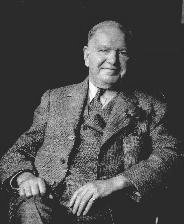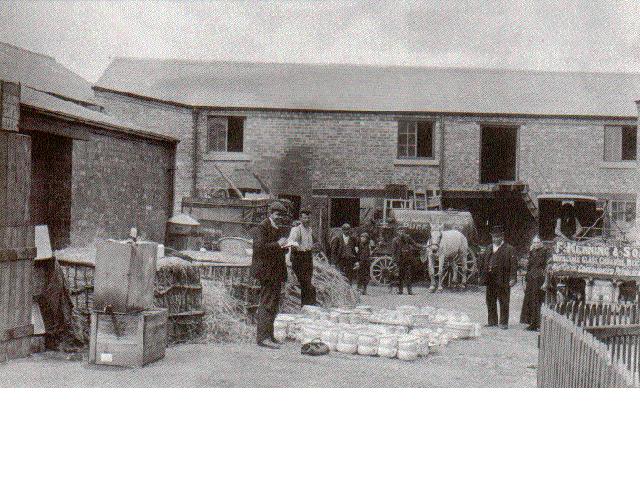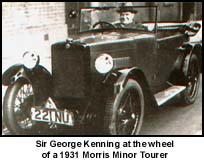The following article by Vivienne Smith appeared in the Derby Evening Telegraph on 28th August 2001
Produced here with the
permission of the
![]()
Sir George Kenning...
WHEELS OF FORTUNE

Sir George Kenning 1880 - 1956
When young George Kenning won a car in a competition in the early 1900's, he immediately saw the potential for distributing and servicing his pioneering form of transport. At his death in 1956 he left a business with a £20m turnover and showrooms all over the country. Vivienne Smith traces the success story of the lad from Clay Cross. Getting your first car can be a memorable experience. But for George Kenning almost a century ago, it was much more than that. Winning one in a competition at the dawn of the motor age, he realised the new mode of transport had great potential. Born in Clay Cross on May 21, 1880, George was the second son of Frank and Ann Kenning. His Father had previously been a miner at the local colliery. But in 1878, Frank Kenning found himself trapped in a cage in a winding incident. He swore that if he got out alive he would never go down the pit again. True to his word, he began hawking door-to-door with a basket of pots instead. Establishing a hardware shop on King Street in Clay Cross, he bought an old colliery horse for £4 and took his goods further a field.

As a young boy, George helped his father on this market stall in Chesterfield, selling everything from matches and soap to pots and pans and paraffin. Leaving school at age 11 he began working for the family business full time.
By the turn of the century, F Kenning & Sons was hawking paraffin oil throughout the Chesterfield area, for in 1901, George's father signed an historic agreement with the Consolidated Petroleum Co Ltd, forerunners of Shell and BP. The paraffin arrived by rail and was transferred into small horse-drawn tankers for delivery to customers.
In 1908, following the death of his father and his older brother Frank, George assumed control of the firm, helped by his younger brother Herbert. The young man soon began to expand the business. He hired out bicycles to the oil companies for their commercial travellers and, purchasing 60 horses, he leased them out to pull the tank wagons.
But a new kind of vehicle was beginning to appear on the country's roads; the motor car. When a soap company ran a competition with a car as the prize, George was determined to win it. The vehicle was to go to the person who sent in the greatest number of soap wrappers. As the young man was already selling the brand in his shop, he persuaded dealers and customers alike to part with their wrappers. Thus did George Kenning secure his first motor car. With an eye to business, he began to see great possibilities in the distribution and servicing of this new mode of transport.
By 1910, he had acquired his first motor agency, becoming a distributor for BSA Royal Enfield motorcycles. Six years later, he became an agent for Ford. Then in 1919 through his friend Dr T F Wilson, a local physician, he was introduced to William Morris. Better known today as Lord Nuffield, Morris had begun building motor cars in a shed behind his office at Cowley a few years earlier. With his dreams of making small cars at affordable prices for the man in the street, he was set to revolutionise Britain's motor industry much as Henry Ford had done in America.
Kenning decided to visit him at Cowley in a bid to win the sole agency for Morris cars in Derbyshire. The meeting was to prove memorable for both men. To pinpoint exactly where Kenning had come from, Morris got out a map. He said, "You ask for the agency of Derbyshire and you live at Clay Cross, a little place near Chesterfield." Kenning was quick to reply, "No, it is Chesterfield near Clay Cross. After all Cowley is not on the map except as a suburb of Oxford, but you make the finest light car here and I will put Cowley on the map; give me the car and I will sell it." And he proceeded to offer a contract for 185 cars. At the time, he did not have the cash to pay for them, neither was it certain that Morris had the capacity to produce them. Yet this did not deter the two men from doing business. Shortly afterwards, Kenning negotiated the sale of the first fleet of Morris cars ever sold: 181 two-seater bullnose Morris Oxfords for Shell representatives. He went on to sell the first three fleets of trucks for Morris as well. Salesmen like George Kenning were vital to the early expansion of Morris Motors, and he and William Morris became good friends. During the 1920s, Kenning was the only company in the country to hold both Morris and Austin distributorships. They also held the first agency granted by the truck making firm Dennis.
George Kenning's reputation as a salesman was legendary. In the early days, he used to collect the cars from Oxford himself and often sold them on the journey back to Clay Cross. As a member of the Chesterfield Hospital Board of Management, he conducted the odd transaction during meetings. Once accused of contributing nothing to the discussion, he equipped, "Not true, I've sold a lorry to the man on my left and a motor car to the man on my right." It was even said that he sold vehicles to all the doctors who had treated him following an operation in 1934.

As well as sales, the businessman provided a growing number of services for car owners. At Kenning depots, customers could not only buy petrol and a variety of accessories; by 1939, state-of-the-art valeting equipment had been installed at the Sheffield and London branches. Vehicles could be washed, vacuum-cleaned and polished in just eight minutes. The London installation could cope with 500 cars a day and was said to be the best equipped valeting station in the world. Another new-fangled invention that fascinated George Kenning was the aeroplane. In the early 1930s, he even piloted a Blackburn Bluebird plane, nicknamed Cobra, in the King's Cup Air Race.
Despite the demands of his growing empire, the businessman maintained an active interest in his native Clay Cross. For almost 30 years, he served both on the Urban District Council and as a member of Derbyshire County Council. In 1931 he gave Kenning Park to his home town as a public recreation ground in memory of his parents. In fact, he was a generous supporter of many good causes. No mean philanthropist himself, Lord Nuffield once commented that George Kenning had "done so much more than people may know". His public and political work in the country even brought him a knighthood in 1943.
When Sir George Kenning died on February 6, 1956, aged 75, more than 500 attended his funeral. Among those present were representatives from every sector of the country's motor trade. The hawker's son from Clay Cross had succeeded in establishing one of the largest car distributors in the land, with a staff of over 2,000 and an annual turnover of £20m. Yet it seems he was not the typical self-made man. Methodist leader Dr W E Sangster added his own tribute to Kenning's obituary in The Times: "He was gentle and unassertive, humble and astonishingly kind, ready to defer to the judgement of others and at ease in all strata of life."
On July 14, 1930, the world of motoring descended on Derby for a rather
special ceremony. Sir William Morris was to open Kenning's new depot in Queen
Street. The company had established its first premises in the town just four
years earlier. But at a cost of £20,000 the new Morris House featured up-to-date
showrooms, garages, repair shops and stores. Every kind of Morris motor was on
display, from the original Morris Minor at £135 to the £285 Morris Oxford Six.
At the opening ceremony, Sir William unlocked the door to the new premises with
a golden key. Afterwards a special luncheon at the Royal Hotel, he praised the
enterprise of his old friend. "Morris Motors", he said, "were very proud of Mr
George Kenning."